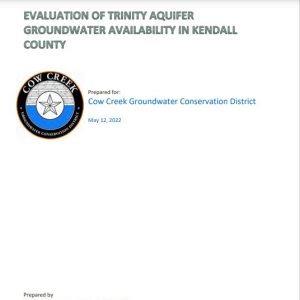Evaluation of Trinity Aquifer Groundwater Availability in Kendall County

Like most areas in the Texas Hill Country, the population and water demand continue to increase in Kendall County. In many areas, the water demand continues to be satisfied by groundwater development. The Cow Creek Groundwater Conservation District (CCGCD) is interested in continuing to implement an appropriate balance between the growing demands for groundwater and conservation and preservation of groundwater resources.
Significant growth in groundwater demand has occurred since the Trinity Hill Country Groundwater Availability Model (THCGAM) was completed in 2000. While the Texas Water Development Board (TWDB) made a minor change in 2009 by incorporating the Lower Trinity Aquifer into the THCGAM, there were no changes in hydraulic properties or pumping distribution in the model with that modification. The current Desired Future Condition in GMA 9 and CCGCD is based on work completed in 2010 during the joint groundwater planning process. A new conceptual model was developed for the THCGAM in 2018 (Green and others, 2018), but that data has not been incorporated into an updated THCGAM. Since 2000, many new wells have been drilled and documented, and the CCGCD has collected significant data regarding pumping and pumping distribution, water levels, and hydraulic properties of the Trinity Aquifer.
It is evident that the Middle Trinity Aquifer continues to receive recharge from precipitation in Kendall County. Water levels in the Middle Trinity Aquifer indicate water level decline is generally limited to a few areas over the past 10 to 20 years. However, some Middle Trinity wells show a continued water level decline over the past 10 to 20 years. Water levels in the Lower Trinity Aquifer indicate a more consistent water level decline. This is partially due to the concentration of the Lower Trinity monitoring wells near developing areas where pumping the Lower Trinity Aquifer has increased. Hydrographs in the Lower Trinity Aquifer indicated a more consistent pattern of water level decline in these areas. Generally, there is reasonable available drawdown in both the Middle and Lower Trinity, but the reduction in available drawdown in some areas should be monitored closely to address long-term groundwater availability.
The differences between CCGCD data and the THCGAM confirm the limitations of the THCGAM to address local management issues, especially in areas where development and groundwater pumping are increasing significantly. Consistent with that limitation, the DFC and MAG estimates should be seen as regional and long-term guidelines only. Because the THCGAM has limits in application on a local scale, the resulting DFCs and MAG estimates are also limited in application on a local scale.
The study results provide the incentive for the CCGCD to consider how local management approaches might impact the balance of production and conservation considering recent hydrologic data and development patterns. If the district adopts a policy of greater conservation, the district may consider reducing the maximum production limit per acre by up to 20%. Additionally, management zones within the district may also be considered in areas of low transmissivity and growing demand if water levels are consistently declining and available drawdown is decreasing. To the degree possible, these policy decisions should be consistent with the DFCs for Kendall County and surrounding areas.